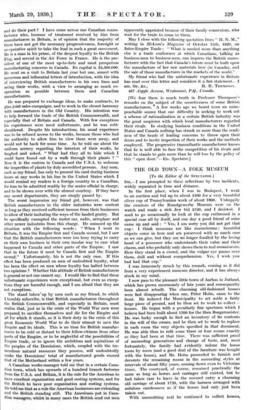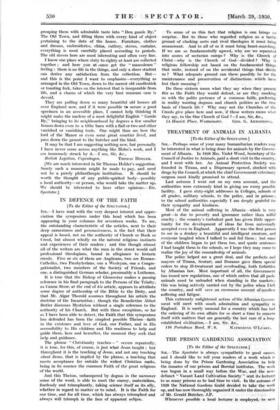THE OLD TOWN—A FOLK MUSEUM
[To the Editor of the SPECTATOR.] SIR,—I am prompted to these reflections by two incidents, widely separated in time and distance.
In the first place, when I was in Budapest. I went to an auction and bid up to about £100 for a very beautiful silver cup of Transylvanian work of about 1800. Unhappily the curators of the Kunstgewerbe Museum were on the watch and made a rich Jew bid £120, and I desisted. I used to go occasionally to look at the cup enthroned in a special case all by itself, and one day a good friend of mine came up and said : " Yes, I am sorry you did not get that cup : I think museums are like mausoleums : beautiful objects come in here and are preserved with as much care as we can give, but they are no longer fondled by the loving hand of a possessor who understands their value and their charm, and who probably only shows them to real connoisseurs. Here they stand in a crowd, and the vulgar eye passes over them, dull and without comprehension. Yes, I wish you had had that cup."
I was immensely struck by this remark, coming as it did from a very experienced museum director, and it has always stuck in my mind.
I now pass to the pleasant little town of Aarhus in Jutland, which has grown enormously of late years and consequently been almost rebuilt. The charming old-fashioned houses were fast disappearing when one, Peter Holm, came to the front. He induced the Municipality to set aside a fairly large piece of ground, and he then set to work to collect— houses. He began with a peculiarly fine specimen which I believe had been built about 1500 for the then Burgermeister. He, was lucky enough to find an inventory of its contents in the will of the owner, and he then set to work to replace in each room the very objects specified in that document. He was able thus to refit some three or four rooms exactly as they had been at that time. There was sufficient proof of succeeding generations and change of taste, and, most fortunately, the family had evidently redone the house room by room (and a good deal of the furniture was bought with the house), and Mr. Holm proceeded to furnish and decorate the remaining rooms in the succeeding styles at intervals of about fifty years, coming down even to Victorian times. The courtyard, of course, remained practically the same so long as horses and carriages still existed, but he had taken care to leave in the covered entry a charming old carriage of about 1750, with the harness arranged with sedulous carelessness as if the horses had only just been taken out.
With unremitting zeal he continued to collect houses, grouping them with admirable taste into " Den gamic By," The Old Town, and filling them with-every- kind of object pertaining to the date of the house. Furniture, clothes and dresses, embroideries, china, .cutlery, stoves, curtains, everything is most carefully placed according to periods. The old stoves here are most interesting and often very fine.
I know one place where sixty to eighty at least are collected together ; and here you at -once get the " mausoleum " feeling : there is no life in the things, and only a sheer student can derive any satisfaction from the collection. But— and this is the point I want to emphasize—everything as arranged in the Old Town, down to the merest old candlestick or toasting fork, takes on the interest that is inseparable from life, and a charm of which the very- best museum- case is devoid.
They arc pulling down so many beautiful old houses all over England now, and if it were possible to secure a good specimen in an accessible place, I cannot help thinking it might make the nucleus of a most delightful English " Gamic By," bringing to its neighbourhood by degrees a few smaller houses down even to a tithe barn with a flail or two and other vanished or vanishing tools. One might thus see how the lord of the Manor or even some great courtier lived, and pass down the gamut to the butcher and the hind.
It may be that I am suggesting nothing new, but personally I have never come across anything like Holm's work, and I urn immensely struck by it.—I am, Sir, &c., -
British Legation, Copenhagen. THOMAS IIOHLER. [We are much interested in Sir Thomas Hohler's suggestion. Surely such a museum might be made to pay, and need
not be a purely philanthropic institution. It should be worth the thought of any public-spirited body—possibly a local authority—or person, who would take the matter up. We should be interested to hear other opinions.—En. Spectator.]















































 Previous page
Previous page